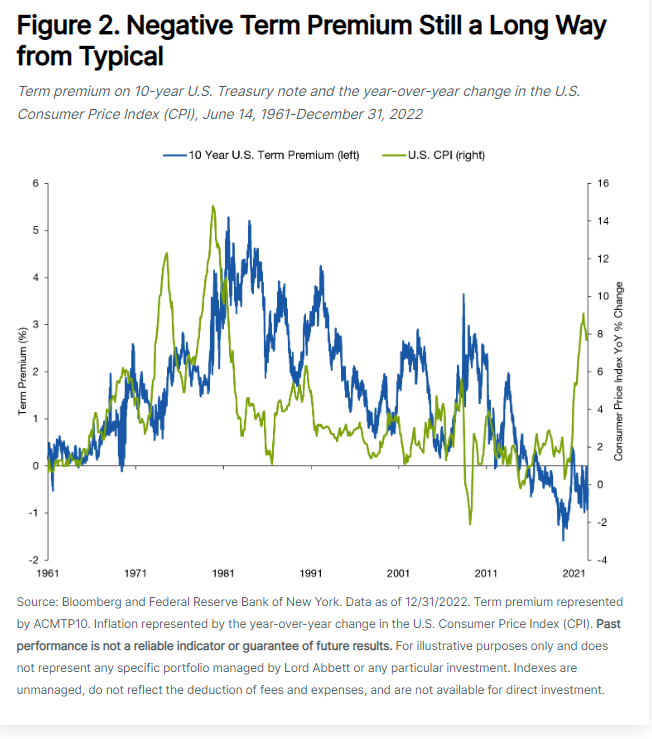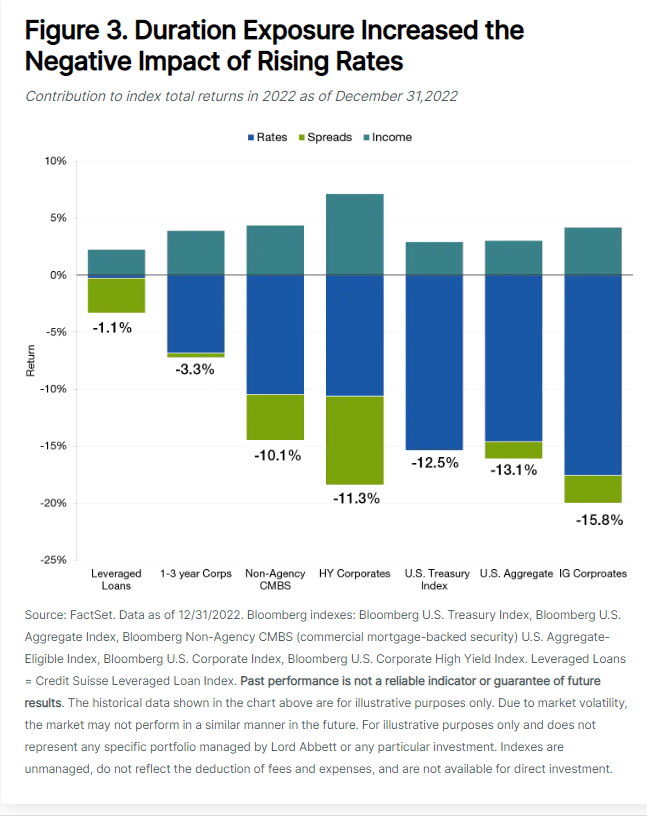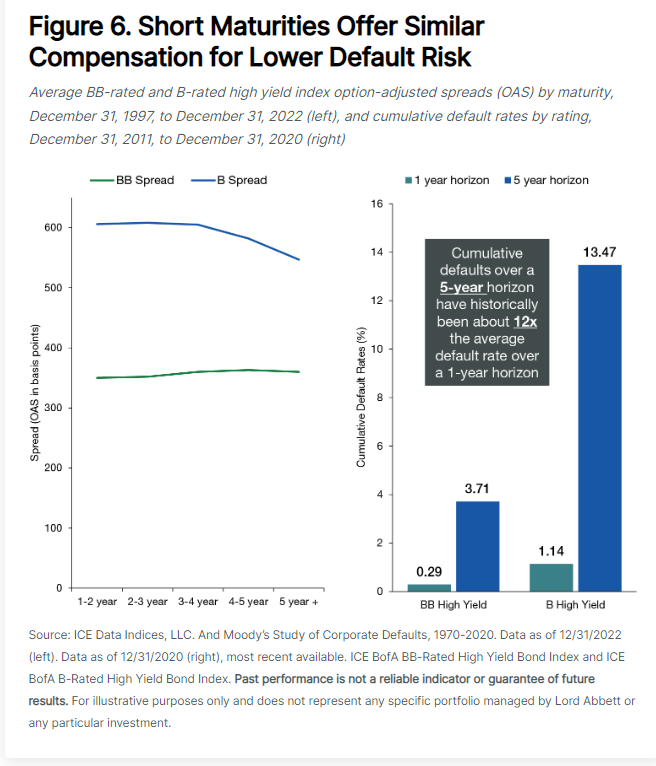Link para o artigo original : https://www.lordabbett.com/en-us/financial-advisor/insights/investment-objectives/putting-yields-to-work–short-duration–high-yield-bonds.html
Income is back in fixed income. The front end of the curve may offer a way to earn that income while avoiding some of the risk.
Attractive Yields While Limiting Rate Risk
We’ve written and spoken a lot about the potential benefits of short-duration credit over the last few years. This focus has been motivated by substantial evidence for long-term outperformance at the short end of the yield curve, as well as the needs of investors to:
1. Earn a return on uninvested cash reserves.
2. Diversify from the term risk prevalent in the rest of the fixed-income market.
Those needs are still pressing today. The drag of holding cash is expensive as inflation continues to run well in excess of pre-pandemic norms. Investors need ways to outpace this inflation with the portion of their portfolios designated for principal protection.
We believe diversifying term risk should also still be a priority for fixed-income investors. Though the yield picture for longer-term fixed income has certainly improved since the beginning of 2022, the yield curve remains stubbornly flat overall and inverted at key points (see Figure 1), providing very little, if any, compensation for taking on incremental interest-rate risk.

Longer-term interest-rate uncertainty—compensation known as “term premium”—may not be properly reflected in long-term bond yields (see Figure 2).

Beyond the tactical consideration of today’s term premium, 2022 taught investors that one common risk, which is the rate risk that comes with longer-term fixed income, can affect every investment in their portfolio together. Adequately priced or not, this risk and its impact on portfolios should be diversified, and short-duration credit is one potential way to limit rate risks associated with longer-term bonds.
The evidence for outperformance of short duration has only improved over the last year, as rising rates damaged longer-term fixed income performance in 2022. Short-duration credit indexes significantly outperformed longer-duration credit segments, with rising rates the primary driver of negative returns as opposed to credit events, shown in Figure 3.

The Low-Risk Anomaly and Higher Risk-Adjusted Returns

The reasons for this anomaly are varied, but some of the most important are as follows:
- Investor attention on higher risk-and-reward opportunities resulting from overconfidence, agency issues, or justification of the time and effort put into the research process—and consequent inattention to low-risk areas.
- Constraints on leverage, particularly in low-spread asset classes where frictional costs inhibit leverage or areas with non-normal distributions of returns. Negatively skewed and fat-tailed returns are less attractive to risk-averse or leveraged investors.
- Non-economic constraints arising from agency issues commonly found in investment guidelines and investment management agreements that limit investor flows to certain issuer types, qualities, registration types, or maturities.
A Flexible, Multi-Sector Approach to Find Excess Returns
We often see these behavioral biases in action within the short-duration credit space. As allocators reel from the speed and magnitude of the rate repricing of 2022 and prepare for a likely recession in 2023, they now have even less reason to go further afield with short-term rates well above their 2021 lows.
As a result, opportunities abound for mandates that can be flexible. For example, currently, investment-grade, securitized issues, such as AAA-rated, short-duration CMBS (commercial mortgage-backed security) and ABS (asset-backed security), offer excellent overall yield and spreads in spaces where the underlying credit is performing well, and the structure is likely to weather even a severe recession (see Figure 5).

The Case for Short-Duration High Yield

The default risk that these yields compensate for increases as the time to maturity increases, of course. What’s less obvious is that this default risk increases more than linearly. For example, a default on a company that currently has adequate cash flow requires a change, a competitive de-evolution. That change tends to be small at first but builds over time. This means the environment generally is not much different over two-year periods but can be remarkably different over five or 10 years. Therefore, default uncertainty increases substantially over that longer time frame. We believe defaults and losses will likely tick up over the next year but will remain low relative to other recessions due to corporate balance-sheet and consumer strength.
The attractive yields and lower defaults on short-duration high yield have contributed to historically higher excess returns over time. Short-duration segments within the ICE BofA U.S. High Yield Index have delivered higher Sharpe ratios compared to longer-duration segments, as shown in Figure 7.


Key Takeaways
Capitalizing on the short-duration anomaly with a flexible, multi-sector mandate allows a well-resourced manager to balance liquidity needs, diversify risk, and earn excess returns from sector rotation and security selection.
Investors focused on return-seeking segments of their portfolios may want to consider a dedicated, short-duration high yield mandate. Attractive historical returns and an excellent yield-and-spread environment leave the asset class attractively positioned on both a relative and absolute basis.
As informações aqui contidas estão sendo fornecidas pela GAMA Investimentos (“Distribuidor”), na qualidade de distribuidora do site. O conteúdo deste documento [e informações neste site] contém informações proprietárias sobre LORD ABBETT e o Fundo. Nenhuma parte deste documento nem as informações proprietárias do LORD ABBETT ou DO Fundo aqui podem ser (i) copiadas, fotocopiadas ou duplicadas de qualquer forma por qualquer meio (ii) distribuídas sem o consentimento prévio por escrito do LORD ABBETT. Divulgações importantes estão incluídas ao longo deste documento e que devem ser utilizadas exclusivamente para fins de análise do LORD ABBETT e do Fundo. Este documento não pretende ser totalmente compreendido ou conter todas as informações que o destinatário possa desejar ao analisar o LORD ABBETT e o Fundo e/ou seus respectivos produtos gerenciados ou futuramente gerenciados. Este material não pode ser utilizado como base para qualquer decisão de investimento. O destinatário deve confiar exclusivamente nos documentos constitutivos de qualquer produto e em sua própria análise independente. Nem o LORD ABBETT nem o Fundo estão registrados ou licenciados no Brasil e o Fundo não está disponível para venda pública no Brasil. Embora a Gama e suas afiliadas acreditem que todas as informações aqui contidas sejam precisas, nenhuma delas faz qualquer declaração ou garantia quanto à conclusão ou necessidades dessas informações.
Essas informações podem conter declarações de previsões que envolvem riscos e incertezas; os resultados reais podem diferir materialmente de quaisquer expectativas, projeções ou previsões feitas ou inferidas em tais declarações de previsões. Portanto, os destinatários são advertidos a não depositar confiança indevida nessas declarações de previsões. As projeções e/ou valores futuros de investimentos não realizados dependerão, entre outros fatores, dos resultados operacionais futuros, do valor dos ativos e das condições de mercado no momento da alienação, restrições legais e contratuais à transferência que possam limitar a liquidez, quaisquer custos de transação e prazos e forma de venda, que podem diferir das premissas e circunstâncias em que se baseiam as perspectivas atuais, e muitas das quais são difíceis de prever. O desempenho passado não é indicativo de resultados futuros.



